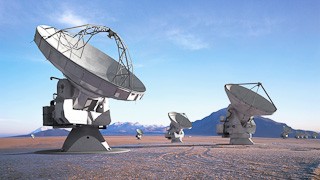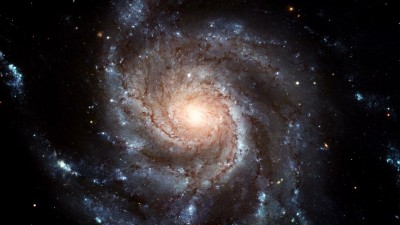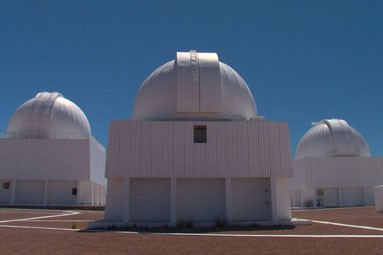| Reviews & Columns |
|
Reviews DVD TV on DVD Blu-ray 4K UHD International DVDs In Theaters Reviews by Studio Video Games Features Collector Series DVDs Easter Egg Database Interviews DVD Talk Radio Feature Articles Columns Anime Talk DVD Savant Horror DVDs The M.O.D. Squad Art House HD Talk Silent DVD
|
DVD Talk Forum |
|
|
| Resources |
|
DVD Price Search Customer Service #'s RCE Info Links |
|
Columns
|
|
|
Nostalgia for the Light

Please Note: The images used here are from promotional stills and other sources, not from the Blu-ray edition under review.
Chile's Atacama Desert, documentarian Patricio Guzman informs us in voice-over as his camera traces the peculiarly reddish ground of this geographically unique place, is the landscape on our planet that most closely resembles the surface of Mars. Its aridity, elevation, rarefied air, and inhospitality to vegetation or other life forms are forbidding, and it has proven fascinating and useful for those with purposes both noble (the desert offers the ideal light and vantage point for astronomers, and is home to several magnificent observatories) and ignoble (it is also littered with the well-preserved remains--thanks to the climate--of exploited 19th-century miners and "disappeared" victims of Chile's 1973 military coup and the subsequent, repressive Pinochet regime, a subject long close to Guzman's heart). Guzman, whose most famous work, The Battle of Chile, concerns itself exclusively and thoroughly with the '73 coup and its disastrous results, seems to have been driven to the desert both by his personal love of astronomy and by its aptness as starting point and central metaphor for his sense of the buried past, of the importance of not dismissing it in the name of moving on. Out of the Atacama and the people connected to it by fulfilling work and painful memory, he weaves a powerful contemplation of the similarities in mission between the astronomers and archaeologists it attracts, of the inevitable preservation of the past (whether as fossils in the ground or as light from a star that no longer exists); and, most potently, of what the desert means for the group of activist women, relatives of some of those "disappeared" under Pinochet, who still seek the remains of their imprisoned and executed loved ones in this place whose remoteness and abandoned mines made it such a convenient location for concentration camps, executions, and mass burials--Pinochet and his right-wing apologists' attempts to eliminate the past, a negating action with longstanding repercussions that Guzman now seeks to counterbalance in some small way with this film.

Guzman opens Nostalgia for the Light on the plane of the vast, almost abstractly majestic, with lovingly framed, awestruck footage displaying the telescopic apparatus of the Atacama's ultra-modern observatories opening up toward the enormous, crystal-clear desert sky. This is quickly followed by glimpses of what the heavens look like through those high-powered eyes, which, as captured by cinematographer Katell Djian (working here quite skillfully and sensitively with DV, as she did on Nicolas Philibert's Nénette, and bringing no less flair and sensitivity to color and lighting to the smaller-scale interview segments than these awesome exterior views), is something dizzying, humbling, and awe-inspiring, like something out of 2001 or The Tree of Life--an effect aided by Miguel Miranda and José Miguel Tobar's score, which recalls nothing so much as Angelo Badalamenti at his most sweetly grandiose and eerie.

The film's scale progresses from the telescopically far-reaching to the televisually human, moving from the skies down to breathtaking landscape shots of the observatories and their surrounding desert and mountains, footage of photographs from the desert's long-ago, problematic mining heyday, and, finally, to standard-scale (but still very nicely shot and recorded) medium-close talking-head interviews with a disparate group of those who have some intimate connection with the Atacama: astronomer Gaspar Galaz and archaeologist Lantano Nunez; former prisoners under Pinochet Miguel Launer and Luis Henriquez; Vicky Saneedva and Violeta Berrios, two of the women seeking their loved ones' remains; and the youngest of the interviewees, Victor Gonzalez and Valentina Rodriguez, both of whose parents were victims of the '73 coup, and both of whom were drawn to astronomy, with its offer of a larger perspective on such human pettiness and cruelty, as a career.

Guzman arranges the interviews to follow a similar path, from the big-picture, abstract, philosophical, and theoretical/scientific (the astronomer and the archaeologist) to the earthly and political (the bereaved, stubborn, persistent women; the children who lost their parents or who grew up in exile because of the Pinochet military state's violent repression), but the distinction between those categories falters and breaks down as we go. Taking care not to downplay or trivialize the differences in degree of suffering and disquiet among his interviewees, Guzman emphasizes again and again what seems to be a basic human impulse they all share and act upon in their own ways: the need to recover, preserve, and understand a past that can seem frustratingly elusive but is essential to furthering our understanding of ourselves and our reality. Each participant shares this commitment to attending to the past, and Guzman's brilliant project, gracefully fulfilled, is to demonstrate, through both exhilarating beauty and heartbreaking horror, that that commitment--whether you are an astronomer or an activist demanding cultural memory and social justice--is one that always has important and ethical implications. The film closes as the women are beckoned by the astronomer toward the telescope's eyepiece to take a look at a more joyous investigation into the past than their own no less vital but much more tragic excavations, an encounter that we see through the veil of a striking visual effect that has been sprinkled intermittently throughout the film by which everything onscreen is suffused with a digitized representation of free-floating stardust that, we are reminded, contains the elemental sources of life from which we and everything we know probably sprang--the perfect visual summation of Guzman's ultimately utopian and optimistic thesis that the past, whether in the form of human memory or of those star-birthed, calcium and carbon particles that are a part of us and everything around us, is never left behind. Instead, it is a continuum that links us to one another and stretches on into the future, and it can never--not by the most massive galactic upheavals, let alone by petty, cruel military dictatorships or complacently forgetful contemporary societies--be obliterated.
THE BD:
Once again, DV source materials prove to be a very nice match for digital home media; the AVC/MPEG-4-encoded, 1080i anamorphic widescreen transfer (at a 1.85:1 aspect ratio) is sparkling clear, with no artifacting in any of the films shadows or blacks, and with only some barely noticeable aliasing on certain bright garments in a couple of scenes.
Sound:The disc's DTS 2.0 soundtrack is full and rich; the score, especially, is resonant and well-accommodated by the mix, but there are no instances of distortion or imbalance at any other aural level.
Extras:The disc contains a gallery of short films that Guzman made with the same crew in conjunction with Nostalgia for the Light, with a very similar, complementary style, look, and musical score. These orbit the main film like so many reflective satellites, each honing in more narrowly on a specific element that the feature has incorporated into its broader perspective:
--Chile: A Galaxy of Problems: Guzman focuses in on the half-repressed ghost of Chile's 1973 military coup d'état, pointing his camera toward psychologists, historians, economists, engineers, and, most disturbingly, a former high military official (the Chilean military has, in Guzman's view, been complicit in a coercive conspiracy of silence in the decades since the coup) in order to shed some light on the reluctance in Chile to face head-on the many unanswered questions raised by the past. For the short's most stark example of why this convenient amnesia has been harmful, a lawyer cites a statistic that only 40% of those victimized under Pinochet have had the crimes against them redressed.
--Oscar Saa, Technician of the Stars: Going behind the scenes of Nostalgia for the Light's observatories, Guzman (doing a good job of walking his Marxist talk) turns his attention to a less-glamorous but essential and equally worthy staff member, following the engineer of the short's title on his technical rounds, and drilling him for some expert insight into the inner workings of the telescope.
--José Maza, Sky Traveler: Structured like something of a Q&A, this short features the titular physicist responding to Guzman's questions about "dark energy," the supernovas that probably initially created the elements we humans now consist of, and his regret over the depersonalization of observatory procedure as they have become more advanced and in-demand.
--Maria Teresa and the Brown Dwarf: The astronomer who in 1997 was the first to actually see a "brown dwarf"--a nascent star that did not have the nuclear capability to become full-fledged--talks about what drives her to be an astronomer, and explains that the same drive is fulfilled on different levels by her collecting of precious stones on the beach and her detail-obsessed avocational creation of tapestries. The short ends in a truly striking overhead shot in which Teresa demonstrates the formation of a galaxy by arranging different kinds of spheres--children's sports balls, oranges, etc.--on a bright-green expanse of lawn.
--Astronomers from My Neighborhood: Guzman documents the ingenuity of several local astronomy enthusiasts who have taken to building their own telescopes from scratch (down to and including creating the special mirrors themselves). These may be "amateurs," but they all--one elderly gentleman in particular, who has designed a mini-observatory on his roof, including hydraulic chair for better access to the eyepiece and a working lavatory to obviate any need to rush downstairs and indoors--demonstrate a resourcefulness, effort, and time commitment that few people bring to their hobbies.
FINAL THOUGHTS:In Nostalgia for the Light, director Patricio Guzman takes thematic elements that seem unrelated and incongruous--on the one hand, his strong feeling that Chile needs to wake up from its "forward-looking" blissful forgetfulness to confront its violent past and bring justice for those still suffering from it; and on the other, his admiration for astronomy, physics, with their expansive vistas of space and time, their radical shifting of concepts like past, present, memory, and our place in the universe--and performs the cinematic alchemy of elegantly synthesizing them into one coherent work. What he comes up with is a remarkable hybrid that is at once a celebratory poem; a defiant, activist political elegy; and a fascinating, accessible exposition of scientific and philosophical thought. It is rare, indeed, to come across an overtly political film that also stares at the sky with this kind of indulgent visual sensuousness, or a scientific documentary that holds itself this rigorously to a high standard of political astuteness and commitment. But in the hands of a filmmaker as adventurous and intellectually/aesthetically well-equipped as Guzman, an experiment this well pulled off can leave you with the perhaps misleadingly optimistic but still thrilling impression that in cinema, there are no limits or rules that cannot be circumvented by the right level of ingenuity, and we really can have it all. Highly Recommended.
|
| Popular Reviews |
| Sponsored Links |
|
|
| Sponsored Links |
|
|
| Release List | Reviews | Shop | Newsletter | Forum | DVD Giveaways | Blu-Ray | Advertise |
|
Copyright 2024 DVDTalk.com All Rights Reserved. Legal Info, Privacy Policy, Terms of Use,
Manage Preferences,
Your Privacy Choices | |||||||












